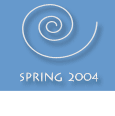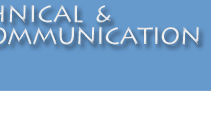



 |
Job
Materials Project- Part One
Purpose
This project is designed to help you evaluate your current professional
and educational qualifications, to strategize ways of expanding these
qualifications while you are still in school, and to begin constructing
internship and/or job application materials to attain an appropriate position.
In the three steps of Part One, you will:
- search for internship or entry-level job announcements in your field
- complete a professional inventory in which you assess your current skills, background, and experience
- construct
a scannable résumé tailored to a specific internship or
job ad based on your completed professional inventory
Step
1- Locating Internship/Job Advertisements
Begin by finding three internship, co-op, or entry-level job advertisements
for a position that interests you and for which you are currently or will
be qualified for upon graduation. These ads should be substantial in terms
of the job description, qualifications/requirements, and organizational
information. Choosing to work with an ad that has less than three paragraphs
of description or that lacks information about how to learn more about
the company/position will make this assignment more difficult and less
useful for you.
Search for specific job titles within your field that interest you and for which you have at least some training or experience. You will use these ads to:
- provide you with key phrases, terms, and descriptions to include in your scannable résumé
- locate areas of development for yourself as a professional. One of the goals of the project is to use these ads to assess your current qualifications and find ways of planning for and gaining experience to help qualify you for such work in the future.
Resources
Searching for internship and job announcements is an on-going process
that requires some ingenuity and creativity. You have to be willing to
investigate possibilities and follow links based on your interest. You
should strongly consider signing up for AggieTrak through NMSU. Try some
of the following databases for getting started:
General-
- AggieTrak http://www.nmsu.edu/pment/sectionthree.htm
- New Mexico State University Job Fair Internship List http://www.nmsu.edu/~pment/intern.htm
- Professional Writing at Purdue University http://pw.english.purdue.edu/resources/employment.shtml
- Resumemagic.com http://www.resumagic.com/x_jobsearch.html
- Internship Search Engine http://internships.wetfeet.com/
- Monster www.MonsterTRAK.com
- Internship USA http://internship-usa.com/
- Intern Web http://www.internweb.com/
- Flip Dog www.flipdog.com
- Dice www.Dice.com
- Career Builder www.careerbuilder.com
Federal Government-
- Student Jobs with US government http://www.studentjobs.gov/
- Professional
positions with US government http://www.usajobs.opm.gov/
Specialized-
- New Scientist Jobs http://www.newscientistjobs.com/
- Nature Jobs http://www.nature.com/naturejobs/
- Science Careers http://recruit.sciencemag.org/
- Information Technology Jobs http://www.itcareers.com/
- American Society of Mechanical Engineers http://www.asme.org/jobs/
- Earthworks (jobs in geology, ecology, science, petroleum http://www.asme.org/jobs/
- Professional
Engineering Organizations list http://www.engineeringjobs.com/groups.html
Regional-
- Craig's List http://www.craigslist.org/
- Job Hunt http://www.job-hunt.org/jobs/newmexico.shtml
- New Mexico High Tech Forum http://www.nmtechjobs.org/
- State of New Mexico http://www.state.nm.us/spo/
Step 2- Professional Inventory
This step of the project asks you to complete the Professional Inventory
which can be downloaded from the course web site or by going to www.hu.mtu.edu/~jasheppa/syllabi/318/proinventory.doc.
The inventory will help you to identify your current skills, abilities,
and understandings in relation to the internship or job ads you have located.
This process will assist you in translating this into marketable résumé
entries by providing evidence of your abilities. It will also help you
to plan your professional development by isolating areas that need improvement.
This form takes you through a sorting, evaluating, and goal setting process
that helps you think about this sort of evidence.
To get the most benefit from the assignment, take your time and work through it seriously. This is a good opportunity to prepare yourself for your future and the rigors of the job search. Further, you should be motivated to develop your inventory thoroughly because it is a substantial part of your project grade. Keep in mind that everyone's inventory is likely to be different. Depending on your major and experiences, you will include different items on your form.
Step 3- Scannable Résumé
Using what you learned from your Professional Inventory, this step of
the assignment asks you to begin constructing your application materials.
You will start by building a scannable résumé in response
to the job ads you have collected.
A scannable résumé differs from a print-based résumé
in that it is designed and organized to maximize your qualifications when
submitted to an electronic database. Organizations use résumé
databases to help them sort through large volumes of applicants and to
hone in on the specific skills and experiences that are important for
a given position.
Content
One way a scannable résumé differs from a print-based résumé
is that they feature nouns to describe your qualifications rather than
verbs to describe what you have done or accomplished (project manager
rather than managed implementation of new accounting software). In order
to maximize the number of "hits" your résumé gets,
you want to be sure to use keywords and jargon specific to your field
(i.e. curriculum development, web design, interdisciplinary collaboration,
user interface design, internship management, etc). You will also want
to look closely at your job ads in order to include phrasing and terminology
used by particular organizations.
Further, the more keywords you use, the more likely your résumé
is to be selected. Expand your list of keywords by including specifics
(e.g., include specific types of computer software, hardware, and operating
system names). Use synonyms for certain skills or descriptions since the
search of résumés may be looking for various options. And
finally, avoid vague language such as results-oriented or proven leadership
qualities and instead focus on concrete descriptions of your experience
(i.e. scholarship recipient or shift supervisor).
Design
The other significant aspect of scannable résumés is in
its design. Many databases are not able to recognize symbols and special
formatting (such as bold or italic text, bulleted or numbered lists, etc.).
It is therefore important that a scannable résumé has a
simple, uncluttered layout. Even though it may
look boring, you should adhere to the following guidelines:
- Start and end with the word "résumé"
- Use 1 inch margins on all sides
- Use a sans serif font that is Mac and PC compatible and that is no smaller than 10 point (Univers, Arial, Helvetica)
- Use a single column layout
- Use the space bar rather than tabs for indentations
- Avoid italics and bolding
- Avoid abbreviations
- Use white space, capitals, and clear section headings to indicate significant information and sections (EDUCATION, EXPERIENCE)
- Don't use bullets, numbered lists, lines, shading, or other graphics
- Do not fold or staple
- Send clean, clear copies that have been laser printed
- Save
your file as text-only (.txt) which can be read by almost any computer
platform and operating system
Resources
Scannable Résumés: The New Technologies for Reading Résumés
By Boise State University
http://career.boisestate.edu/ScannableResumes.html
How to Write
a Scannable Résumé
By University of Kentucky
http://www.uky.edu/CareerCenter/scanhowto.html
Internet-Friendly
and Scannable Résumés
by Jeff Farris
http://web.imanet.org/academia/library/farris.htm
Creating
a Scannable Resume
by University of Dayton
http://careers.udayton.edu/Services/resscannable.asp
Timeline for Job Materials Project Part 1
- Wednesday, February 3rd- Hardcopies of Three Job Ads due
- Wednesday, February 3rd- Professional Inventory due
- Monday, February 9th- Draft of Scannable Résumé due
- Wedneday, February 18th- Revised version of Scannable Résumé due